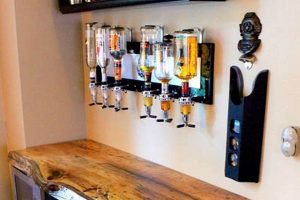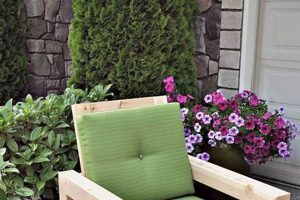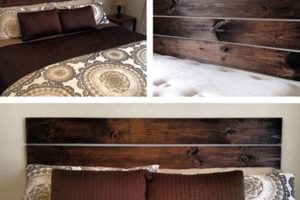The concept embodies a range of projects focused on creating or modifying surfaces in food preparation areas using individual effort and readily available materials. These endeavors can encompass resurfacing existing structures, building new installations from scratch, or adding decorative elements to enhance both the functionality and aesthetics of the space. As an example, a homeowner might choose to apply an epoxy coating to an older laminate surface, thereby extending its lifespan and improving its visual appeal.
Undertaking such initiatives can offer several advantages, including cost savings compared to professional installations and the ability to personalize the design to match specific preferences. Historically, such projects have gained popularity as homeowners seek to increase property value and express their creativity within their living environments. The accessibility of information and materials has further fueled the trend, empowering individuals to take control of their home improvement endeavors.
The subsequent sections will delve into specific material choices, techniques for surface preparation, and finishing methods that are commonly employed in these projects. Furthermore, the discussion will address considerations for budget management, safety precautions, and the relative difficulty levels associated with various approaches.
Essential Considerations for Kitchen Counter Projects
Successful execution necessitates careful planning and adherence to sound construction principles. The following tips provide guidance for navigating the complexities and ensuring a durable and aesthetically pleasing outcome.
Tip 1: Material Selection is Paramount: Choose materials appropriate for the intended use and the environment. Consider factors such as heat resistance, water resistance, and ease of maintenance. For example, concrete counters offer significant durability but require sealing to prevent staining. Laminate provides affordability but may be susceptible to damage from high heat.
Tip 2: Surface Preparation is Critical: Proper preparation ensures adequate adhesion and a smooth finish. Thoroughly clean and sand existing surfaces to remove any loose particles or contaminants. For example, when applying epoxy, the existing counter must be free of grease and thoroughly abraded to promote bonding.
Tip 3: Accurate Measurements are Non-Negotiable: Precise measurements are essential to avoid material waste and ensure a proper fit. Double-check all dimensions before cutting materials. For instance, when constructing a new countertop frame, accuracy will prevent gaps and structural instability.
Tip 4: Employ Appropriate Tools and Equipment: Utilize the correct tools for each stage of the process. Employ safety equipment, such as eye protection and respirators, to minimize risks. Using a power sander without proper dust collection can create a hazardous environment and compromise the finish.
Tip 5: Adhere to Sealing and Finishing Procedures: Proper sealing and finishing protect the surface and enhance its longevity. Follow the manufacturer’s instructions for application and curing times. Failing to properly seal a wood countertop will leave it vulnerable to water damage and bacterial growth.
Tip 6: Understand Building Codes and Regulations: Prior to commencing work, familiarize oneself with local building codes and regulations pertaining to kitchen installations. Non-compliance may result in costly alterations or fines. For example, electrical outlets near sinks must adhere to specific grounding requirements.
Tip 7: Plan for Plumbing and Electrical Considerations: Carefully consider any plumbing or electrical modifications required for the project. Disconnecting and reconnecting plumbing or electrical systems should be performed by qualified professionals. Improperly installed wiring can create a fire hazard.
Careful adherence to the aforementioned guidelines provides a framework for successful execution, thereby enabling the creation of attractive and functional surfaces within the kitchen environment.
The subsequent section provides guidance to project planning.
1. Material durability assessment
Material durability assessment is a foundational step when considering various surface solutions. This process involves evaluating the inherent resistance of different materials to wear, impact, heat, water, and chemical exposure, all of which are commonplace in kitchen environments. The selection of an appropriate material significantly influences the longevity, maintenance requirements, and overall satisfaction with the finished product.
- Resistance to Impact and Abrasion
The capacity of a material to withstand physical impacts and abrasive forces is a critical consideration. Materials such as quartz and concrete exhibit high resistance to scratching and chipping, making them suitable for high-traffic areas and households with children. Laminate surfaces, while more affordable, are more susceptible to damage from sharp objects and require greater care in daily use.
- Heat Resistance and Thermal Shock
The ability to withstand high temperatures without warping, scorching, or cracking is crucial for surfaces near cooking appliances. Granite and certain types of engineered stone possess excellent heat resistance, allowing for the placement of hot pots and pans directly on the surface. Wood surfaces, however, require the use of trivets to prevent damage from heat exposure.
- Water Resistance and Stain Prevention
Kitchen environments are prone to spills and moisture exposure, making water resistance an essential characteristic. Non-porous materials like stainless steel and solid surface are highly resistant to water absorption and staining. Porous materials, such as natural stone and wood, require sealing to prevent the penetration of liquids and potential staining from food and beverages.
- Chemical Resistance and Cleanability
Exposure to cleaning agents and household chemicals is inevitable in a kitchen setting. Materials should be able to withstand regular cleaning without discoloration, etching, or degradation. Quartz and stainless steel are known for their resistance to a wide range of chemicals, while some natural stones may be susceptible to damage from acidic cleaners.
Integrating a thorough material durability assessment into the planning phase ensures that the selected surface aligns with the specific needs and usage patterns of the kitchen. This proactive approach minimizes the risk of premature failure, costly repairs, and dissatisfaction with the finished product. A reasoned evaluation, accounting for factors like impact resistance, heat resilience, water impermeability, and chemical inertness, is a critical foundation for a successful and long-lasting project.
2. Cost-effective solutions
The pursuit of affordability is a central driver for many who choose the self-directed approach for kitchen improvements. Implementing budget-conscious strategies allows individuals to achieve desired aesthetic and functional enhancements without incurring the significant expenses associated with professional contracting and high-end materials.
- Material Repurposing and Upcycling
The utilization of reclaimed or repurposed materials offers a significant avenue for cost reduction. Salvaged wood, for example, can be transformed into unique and character-rich surfaces at a fraction of the cost of new lumber. Similarly, concrete remnants can be molded into custom designs. Careful sourcing and preparation are essential to ensure both structural integrity and aesthetic appeal.
- Laminate and Alternative Surface Options
Laminate surfaces provide an economical alternative to natural stone or solid surface materials. Advances in manufacturing have resulted in laminate products that mimic the appearance of more expensive materials with considerable accuracy. While laminate may not possess the same longevity or durability as higher-end options, it offers a practical and visually appealing solution for budget-conscious projects.
- Resourceful Tool Acquisition and Rental
The purchase of specialized tools can represent a substantial upfront investment. Exploring options such as tool rental programs or borrowing from community workshops can significantly reduce project costs. Strategic planning and efficient utilization of resources are paramount to minimizing unnecessary expenditures.
- DIY Installation and Labor Savings
The most significant cost savings typically arise from performing the labor oneself. Eliminating professional installation fees can dramatically reduce the overall project budget. However, it is essential to realistically assess one’s skills and capabilities to avoid costly mistakes that may necessitate professional intervention.
The integration of these cost-effective strategies empowers individuals to realize their kitchen renovation aspirations without exceeding their financial constraints. Careful planning, resourceful material sourcing, and a commitment to self-directed labor are key to achieving a successful and affordable surface transformation.
3. Structural Integrity
Structural integrity, in the context of crafting kitchen work surfaces, denotes the ability of the assembly to withstand anticipated loads and stresses without deformation, failure, or functional impairment. It is a non-negotiable attribute, directly influencing the safety, longevity, and usability of the installation.
- Foundation and Support Framework
The foundation, which could be existing cabinetry or a newly constructed base, must be capable of bearing the weight of the surface material and any objects placed upon it. An inadequate foundation can lead to sagging, cracking, or complete collapse. For example, a heavy concrete surface requires a reinforced frame to prevent stress fractures and ensure long-term stability.
- Material Selection and Load-Bearing Capacity
The chosen material must possess sufficient strength to withstand anticipated loads. Different materials have varying load-bearing capacities; a thin layer of laminate will not support the same weight as a slab of granite. Selecting a material with an insufficient load-bearing capacity can result in deflection, cracking, or catastrophic failure under normal use.
- Joints and Connections
The joints and connections between individual components must be robust and secure. Weak joints can compromise the overall stability of the assembly. For instance, inadequately fastened corners in a wooden frame can lead to instability and eventual separation, particularly under repeated stress or moisture exposure. The use of appropriate fasteners, adhesives, and joinery techniques is paramount.
- Surface Reinforcement Techniques
Reinforcement techniques can enhance the structural integrity of certain materials, particularly those that are inherently weaker or prone to cracking. Embedding reinforcing elements, such as steel mesh in concrete or fiberglass mat in resin composites, can significantly increase tensile strength and impact resistance, extending the lifespan and improving the performance of the finished surface.
These facets are critical to realize a safe and durable outcome. The implementation of sound engineering principles and meticulous attention to detail are essential for ensuring that the finished installation meets the demands of daily use and provides years of reliable service. Neglecting structural integrity considerations can lead to costly repairs, safety hazards, and a diminished lifespan for the surface.
4. Design Adaptability
Design adaptability plays a crucial role in the realm of self-directed surface construction, allowing for the tailoring of functional elements to meet specific spatial constraints and personal preferences. The ability to modify designs based on available resources, existing infrastructure, and aesthetic inclinations defines the potential for successful project execution. Furthermore, consideration of future modifications or expansions contributes to the long-term utility of the surface.
- Spatial Configuration Flexibility
The dimensions and layout of a kitchen often present unique challenges that standard, pre-fabricated solutions fail to address. Design adaptability allows for the creation of surfaces that conform to unconventional spaces, irregular wall angles, or limited square footage. For instance, a custom-built corner element can maximize workspace in a small kitchen, whereas a standard unit might leave unusable gaps. Precise measurement and planning are essential for seamless integration within the given environment.
- Material Palette Customization
The selection of materials directly influences the visual appeal and functional characteristics of the finished product. Adaptability allows for the blending of different materials to achieve specific aesthetic goals or to leverage the unique properties of each. For example, a surface might incorporate a combination of reclaimed wood for rustic charm and stainless steel for enhanced durability in high-use areas. The blending of materials requires consideration of compatibility, contrasting textures, and appropriate sealing techniques.
- Integrated Functionality and Storage Solutions
Beyond providing a working surface, integration of additional features, such as built-in cutting boards, knife blocks, or charging stations, can significantly enhance functionality. Design adaptability enables the incorporation of these elements seamlessly into the overall structure. For example, a shallow drawer built into the edge of the surface can provide convenient storage for frequently used utensils, optimizing space utilization and workflow efficiency.
- Aesthetic Personalization and Style Integration
The opportunity to express personal style and preferences represents a key advant
age. Adaptability enables the customization of colors, textures, and finishes to align with the overall kitchen design. Staining or painting a wooden surface to complement existing cabinetry or incorporating decorative inlays to create a unique focal point demonstrates the potential for personalization. Careful selection of finishing materials and techniques is essential to ensure durability and compatibility with the chosen materials.
The foregoing facets underscore the significance of design adaptability in the context of self-directed surface projects. By allowing for the tailoring of spatial configurations, material palettes, integrated functionalities, and aesthetic elements, design adaptability empowers individuals to create work surfaces that are not only functional but also reflective of their unique needs and personal style. The considerations outlined above contribute to enhanced space utilization, workflow efficiency, and overall satisfaction.
5. Surface sealing techniques
Surface sealing constitutes a critical phase in the fabrication and maintenance of kitchen work surfaces, impacting durability, hygiene, and aesthetic longevity. Selection and application of appropriate sealants mitigate porosity, prevent the ingress of liquids and contaminants, and enhance resistance to wear and chemical exposure.
- Selection of Sealant Type
The choice of sealant hinges on the material composition of the surface. For porous materials like concrete or natural stone, penetrating sealants are preferred. These sealants, typically composed of silanes or siloxanes, permeate the surface, creating a hydrophobic barrier within the material matrix. Non-porous materials like epoxy or certain solid surfaces may require only a topical sealant to enhance scratch resistance and gloss. An incorrect sealant choice can lead to ineffective protection or material damage.
- Surface Preparation Protocols
Effective sealant application mandates meticulous surface preparation. The surface must be clean, dry, and free from debris, grease, or previous coatings. Depending on the material, sanding or etching may be necessary to promote sealant adhesion. Failure to properly prepare the surface can result in uneven sealant penetration, blistering, or premature sealant failure. The application environment (temperature and humidity) also influences the sealing outcome.
- Application Methods and Techniques
Sealants can be applied via brush, roller, or spray, depending on the sealant viscosity and the surface texture. Multiple thin coats are generally preferable to a single thick coat to ensure uniform coverage and prevent pooling. Proper ventilation is essential during application to minimize exposure to volatile organic compounds (VOCs). Overlapping strokes and consistent application pressure contribute to a seamless, protective layer. Insufficient sealant application can leave areas vulnerable to staining and moisture damage.
- Curing and Maintenance Procedures
Sealants require specific curing times to achieve optimal performance. Adhering to the manufacturer’s recommendations regarding curing temperature and humidity is crucial. Periodic reapplication of the sealant is necessary to maintain its protective properties, particularly in high-use areas. Regular cleaning with pH-neutral cleaners helps to prevent the degradation of the sealant layer. Neglecting sealant maintenance can compromise the long-term durability and hygienic properties of the surface.
The described facets of surface sealing, when properly addressed, contribute significantly to the success of kitchen counter projects. Attending to each detail will help to deliver functional surfaces with long-lasting resilience and aesthetic appeal.
6. Installation precision
The success of any kitchen work surface, especially those undertaken through individual initiative, hinges critically upon installation precision. This aspect encompasses accurate measurements, meticulous alignment, and secure fastening. Deviations from precise installation protocols can precipitate structural weaknesses, aesthetic flaws, and functional deficiencies, thereby negating the benefits sought through a do-it-yourself approach.
Consider, for example, the installation of a concrete countertop. If the supporting cabinetry is not perfectly level, the concrete surface will be subjected to uneven stress, potentially leading to cracking. Similarly, gaps between the countertop and adjacent walls, resulting from imprecise cutting or alignment, can trap food particles and moisture, fostering unsanitary conditions and material degradation. Achieving proper overhangs to protect cabinet faces and ensuring flush transitions with sinks and appliances demands careful execution. Furthermore, secure fastening of the countertop to the base cabinets prevents movement and ensures stability during use. The consequence of neglecting these details can range from minor aesthetic imperfections to significant structural failures, necessitating costly repairs or replacements. Proper planning and attention to detail is therefore vital to reduce those problem.
In conclusion, while the cost savings and customization opportunities associated with do-it-yourself kitchen work surfaces are attractive, installation precision must be prioritized. Accurate measurements, level supports, proper alignment, and secure fastening are indispensable for realizing a durable, functional, and aesthetically pleasing outcome. Addressing these factors contributes to a successful project and extends the lifespan of the installation.
Frequently Asked Questions
The following addresses common inquiries related to implementing kitchen work surfaces through individual initiative. The responses aim to provide clarity and guidance for optimal project outcomes.
Question 1: What are the most durable materials for a budget-conscious kitchen surface?
Laminate offers a cost-effective option with acceptable durability for typical use. Concrete, when properly sealed, provides significant longevity. Wood, while aesthetically pleasing, requires ongoing maintenance and is susceptible to water damage if not adequately protected.
Question 2: How is a structurally sound base frame constructed for a concrete work surface?
The frame necessitates robust materials, such as steel or reinforced wood. The design must account for the substantial weight of the concrete. Adequate cross-bracing and secure connections are essential to prevent sagging or failure.
Question 3: What considerations are paramount when integrating a sink into a DIY work surface?
Accurate measurements are crucial for a precise cutout. Proper sealing around the sink perimeter prevents water intrusion. Adequate support beneath the sink is necessary to bear its weight and the weight of water-filled vessels.
Question 4: What are the critical safety precautions when working with epoxy resins?
Epoxy resins release volatile organic compounds (VOCs). Adequate ventilation is mandatory to prevent respiratory irritation. Skin contact should be avoided through the use of gloves. Eye protection is essential to guard against splashes.
Question 5: How is a seamless finish achi
eved when joining two sections of a laminate work surface?
A color-matched seam filler or caulk is typically used to conceal the joint. Proper clamping and alignment during installation minimize the visibility of the seam. A router with a flush-trim bit can ensure a smooth transition between the two sections.
Question 6: What are the recommended cleaning practices for maintaining various work surface materials?
Laminate requires gentle, non-abrasive cleaners. Concrete benefits from pH-neutral solutions. Wood requires regular oiling or sealing to prevent water damage. Harsh chemicals should be avoided to prevent discoloration or etching.
Consideration to the questions above allows for better and long-term projects.
kitchen counter ideas diy
The preceding exploration has illuminated various facets, encompassing material considerations, structural requirements, design adaptability, sealing techniques, and installation precision. Adherence to these guidelines facilitates the creation of functional, durable, and aesthetically pleasing kitchen work surfaces through individual effort. Prioritizing durability, cost-effectiveness, and precise execution is vital for successful project completion.
The insights provided offer a foundation for informed decision-making and skillful implementation. Whether undertaken for cost savings, customization, or personal enrichment, these projects demand careful planning, diligence, and adherence to established best practices. Continued diligence will lead to a project with enhanced value and lasting appeal.







